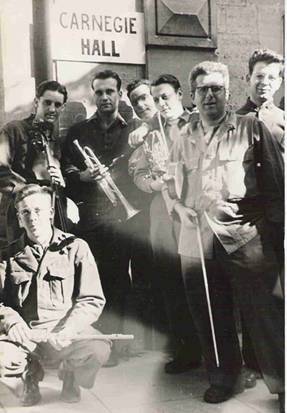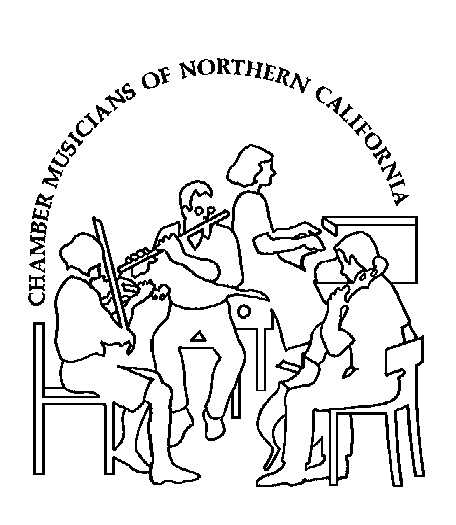Chamber Musicians of Northern California
Providing opportunities for musicians
to play and enjoy chamber music.
Find out about CMNC's Aims and Purposes
Take a look at CMNC's Library!
The GI Symphony after World War II
by Ralph Morrison
(This excerpt from a longer story begins in 1944. The war had ended, but large numbers of soldiers were in Europe, waiting for their chance to go home.)
The army did its best to keep us busy while we waited for our numbers to come up. On a pass to Paris, I ran across a notice that a GI symphony was being formed. This became my priority, and soon I was filling out an application. Within two weeks, I received orders to report for service. They gave me a violin to play, and I was a happy soldier.
Just after I arrived, the orchestra was moved from Paris to a suburb called Chatou. This was a real change in lifestyle for me—from a tent on the edge of an abandoned airstrip to a real bed in a chateau. The orchestra had already begun playing together when I arrived, and someone had put up a sign naming our chateau “Carnegie Hall.” At my first rehearsal, we played the Overture to Oberon by von Weber. I felt we sounded terrific.
Being stationed near Paris had its benefits. We had little money, but the Metro was free to GIs, there were no fees required to see the museums, and we ate at the Red Cross. I saw some operas and even attended a London Philharmonic concert. Afterward I went backstage and shook hands with Sir John Barbirolli.
The French government wanted fewer GIs roaming the streets of Paris, and within a few months, the orchestra was ordered to move to Frankfurt am Main. We rehearsed in the Palmgarten and were billeted six to a small apartment some distance away. I shared an apartment with a horn player named William Klang. Later he married an English girl and found a position in the London Philharmonic.
The orchestra was formed to give concerts for GIs across Europe. When we got to Frankfurt, an advance team had already been out making plans for our grand tour. This meant planning everything from sleeping accom-modations to theaters to putting up posters. Our transportation was to be a fleet of ambulances, which were no longer needed now that fighting had ceased.
Our conductor was a man named John Brown. I felt he had a lot of charisma as well as a flair for conducting that carried him well with both the orchestra and the audience. Although he did not become as well known as some orchestra members, I believe he did have a conducting career in the New York area. Our concertmaster, Stuart Canin, on the other hand, did become very famous. He was from Philadelphia, but he eventually came out west to become concertmaster of the San Francisco Symphony. In the GI Symphony, he was also a soloist in Wieniawski's First Violin Concerto.
Another orchestra member who went on to great things was Sol Greitzer. At that time, he played violin, but he later became principal violist of the New York Philharmonic. The cello section was led by Roland Leich, who would become head of the music department at Carnegie Mellon University.
We rehearsed two full programs. The works included Smetana's Overture to The Bartered Bride, Berlioz's “Hungarian March,” Schubert's Unfinished Symphony, Beethoven's First Symphony, Eric Coates' London Everyday Suite, and music from Oklahoma. In the fall of 1944, we boarded our ambulances and began our tour.
There were many memorable stops. We drove up the Autobahn through several checkpoints to Berlin, which was a divided city. The bomb damage was unbelievable. I went down into the bunker where Hitler died. This was in the Russian sector, and I was watched by a Russian soldier with a rifle over his shoulder. It was bitterly cold that winter, and people were scrounging for wood to burn. Our concert was in a theater called Onkel Tom's—a very nice place.
The orchestra visited Garmisch Parten-kirchen, near Berchtesgarten, where Hitler had his Eagle's Nest. This area was a popular recreation spot for GIs on leave. The orchestra had a fine time skiing and sightseeing. The tramways were working, and I tried to ski on Mount Wank. Another GI in the group decided to show off by skiing down a small hill. He fell and lost his skis, which sailed down the mountain. We hiked down through deep snow to retrieve them. When we got back to the ski area we were exhausted. I never did get to ski.
Some players discovered that Richard Strauss lived nearby. For some reason, I decided not to try to see him, a decision I regret to this day.
When we left Garmish, we dropped out of the snow into lush country near Munich. When I looked back at the Bavarian Alps, I recalled the definition of eternity. If a canary came once a year to rub his beak on these mountains, the time to wear down the mountains would be one day of eternity.
The orchestra played in the Festspielhaus in Bayreuth, Bavaria—the opera house designed by Richard Wagner. At that time, I had no idea how famous it was, and I remember almost no details, just that it had a very large stage.
We played concerts in Nuremberg as well and were able to visit the war crimes trial going on there. We waited in line for a long time and then were let into the visitors' gallery for a short stay. The scene I saw was the same one captured by photographs in the many stories about these trials. I saw Himmler and Goering sitting there looking very glum with their headsets on.
We visited Vienna and played in the Schönbrunn Palace. I walked the Ringstrasse and saw the damaged opera house. I went into the eastern sector, and there my camera was confiscated by a Russian soldier. I remember a kindly citizen rescuing my precious camera for me after the soldier had exposed all my film. I liked Vienna and could see that it was a very beautiful city, despite the great damage. Many years later, I returned to play music with a friend who had retired there. The city had come back to life.
Other cities we visited included Bad Tolz and Regensburg. We spent long hours in the back of the ambulances and covered long distances on the mostly empty Autobahns. We couldn't see the scenery, but at least the ambulances were heated, a far cry from the open 6 by 6 trucks that had been my transportation during the war.
Sometime during this tour, an amazing event occurred that I had no idea of at the time. I learned of it many years later, when Stuart Canin visited us in Eureka after a performance by the New Century Chamber Orchestra. We were looking at my album of pictures of the GI Symphony, and he recalled that one night when we were in Berlin he had heard a knock on his door. He was asked to come and bring his violin, told only that he was to play a private concert. He was driven some distance, with no idea where he was going. Finally, he was taken to a room that held only three men. The small town outside of Berlin where he had been taken was Potsdam; the three men were Churchill, Truman, and Stalin.
When we returned to Frankfurt in the early spring of 1945, the orchestra disbanded. We could have continued touring, but too many players wanted to go home. Many numbers had come up at last, including mine. In late March, I boarded a Kaiser-built Liberty ship called the Sea Fiddler (!) for the return trip across the Atlantic. This time there were no navy escorts or sounds of depth bombs going off. We were returning to a country at peace.

More Gems | Home | Contact CMNC
© Copyright CMNC 2006
